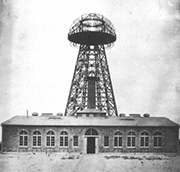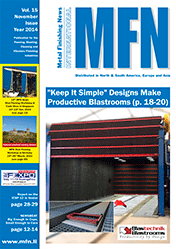E-Archive
Off the Beaten Track
in Vol. 15 - November Issue - Year 2014
Integral Calculus

The Wardenclyffe Tower, demolished in 1917
The math teacher's face grew taut and his fingers twirled a pencil with increasing impatience. The veins on his neck seemed to be on the point of bursting, while his face turned a deep red. Finally, he snapped the pencil in two as he slammed an open hand on the desktop. He knew that the young student sitting in front of him was cheating, but he was utterly frustrated by his own inability to discover how the student was doing it.
*****
Nikola Tesla is considered a forgotten genius, whose electrical and mechanical inventions and scientific intuitions have begun to be fully appreciated only in recent times. He was born in 1856 to Serbian parents in Croatia, at that time part of the Austrian Empire. He inherited a passion for creating household and mechanical appliances from his mother, from whom he also drew an excellent eidetic memory. At school in his early teens, his teachers could not believe that he was able to perform complex integral calculus in his head and they accused him of cheating at his exams. He completed a four-year high school term in three years. As a young man, he developed these skills into an uncanny ability to visualize in his mind complex machinery and mathematical equations with extreme precision, without needing to put anything on paper. He amazed fellow workers by designing and developing machines only in his mind, improving on the design in successive steps until the machine was ready for production, without having to build prototypes.
However, everything did not always go well during his formative years. After a promising start at the Austrian Polytechnic in Graz where he earned top grades and where he worked for up to twenty hours a day, Tesla had a strong disagreement with one of his professors and quickly lost interest in his studies. He became addicted to gambling and dropped out of school, suffering a nervous breakdown shortly afterwards. He never completed his formal studies and never graduated from university. His family helped him to get back on his feet, and he attended lectures at the Charles-Ferdinand University in Prague, although he never enrolled and therefore never got credits for his studies.
One of Tesla's first jobs was with the Telephone Exchange in Budapest, where he perfected a new design for a telephone amplifier. In 1882 he moved to France and worked for the Continental Edison Company, where he so impressed his bosses with his technical skills that they recommended him for a job at the company's head office in the United States, working directly with the company's founder, Thomas Edison. Edison recognized Tesla's capabilities and soon asked him to completely redesign the Edison Company's direct current generators. Tesla greatly improved the efficiency and the economy of this equipment, but the two men quarreled when Edison reneged on his promise to pay Tesla a considerable amount of money for his successful completion of the project, and Tesla resigned.
After an unsuccessful attempt at a partnership with two American businessmen in 1886 during which he lost control of his first patents for electrical arc lighting systems, dynamos and dynamo commutators, Tesla teamed up with another two businessmen to form the Tesla Electric Company, where a laboratory was set up to allow Tesla to continue his research and his development of various types of electrical equipment. In 1887, Tesla invented the alternating current induction motor. This device had a simple design that used polyphase electric current and which did not need a commutator and mechanical brushes, thus all but eliminating the high maintenance costs typical of direct current equipment. His inventions came to the attention of George Westinghouse, who had been looking for a way to compete against the direct current system promoted by Thomas Edison. This led to the so-called "War of Currents", as the two sides fought fiercely to convince the American public and industries to adapt either one or the other electric power distribution system in the United States, a potentially huge and rich market*.
By 1891, Tesla had developed a system of wireless power transmission, demonstrating the possibility of lighting electric lamps without any cable connection.
In 1894, he turned his attention to the study of x-rays, which at that time appeared as a mysterious force that baffled scientists. He developed his own design for a high-energy single terminal vacuum tube with no target electrode.
In the late 1800's Tesla conducted several radio wave experiments and demonstrated a radio-controlled boat at a public exhibition in New York in 1898.
At the start of the new century, Tesla obtained patents for a system of wireless electric energy transmission and started construction of a fifty-seven meter tall tower at Wardenclyffe on Long Island. This facility was to demonstrate the possibility of transmitting electric energy across the Atlantic Ocean, but construction remained uncompleted because of lack of funding.
* See "The War of Currents" in MFN magazine,
September 2014.
By Giovanni Gregorat, Contributing Editor MFN
Author: Giovanni Gregorat




























